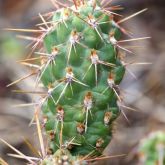Jumping cholla
Alert
Have you seen Jumping cholla?
Be on the lookout for Jumping cholla and report it to Biosecurity Queensland. Early detection and reporting are the key elements in preventing Jumping cholla from becoming a major problem in Queensland.
Call us on 13 25 23.

Jumping cholla flower
© Steve Koch Creative Commons

Jumping cholla plant
© Queensland Government

Jumping cholla cladode
© Queensland Government
Native to California and Mexico, jumping cholla is small shrub with stems that detach when slightly touched, giving the appearance of jumping short distances. It is occasionally naturalised around Lightning Ridge and Broken Hill in New South Wales and is listed as Weeds of National Significance which covers Austrocylindropuntia, Cylindropuntia and Opuntia species.
You must manage the impacts of Jumping cholla on your land.
You must not give away, sell or release Jumping cholla into the environment.
You must report all sightings to Biosecurity Queensland within 24 hours.
Scientific name
Other names
- Coastal cholla
Similar species
- Snake cactus
Description
- Low shrub up to 0.4–1m tall.
- Spines are light to dark brown, 7–11 per areole, 1–2cm long, interlacing, white to light-tan sheath firmly attached.
- Flowers are rose to magenta, 25–30mm wide.
- Stem segments are dull-green to greenish-grey, whorled or subwhorled, cylindrical, 4–15cm long, 4–5cm wide, waxy flaky surface when dry. Prominent tubercles and segments easily detached.
- Fruit are obovoid to globose, solitary or forming chains, up to 20–50mm long, green.
Habitat
- Prefers semi-arid and arid rangeland in subtropical areas.
Distribution
- Small infestation found in Longreach, Queensland.
Impacts
Environmental
- Destroys native pastures.
Economic
- Becomes costly and time-consuming to control.
Social
- Sharp spines threaten native animals, bushwalkers and farm animals.
- Spines can penetrate boots and tyres.
How it is spread
- Spread by animals, vehicles and people.
- Can spread vegetatively.
- Spread by seed not seen in Australia.
Prevention
Control
Phone 13 25 23 if you find a plant you suspect may be jumping cholla to seek advice on control options.
Legal requirements
- Jumping cholla is a category 2, 3, 4 and 5 restricted invasive plant under the Biosecurity Act 2014.
- You must not keep, move, give away, sell, or release into the environment. Penalties may apply.
- All sightings of jumping cholla must be reported to Biosecurity Queensland within 24 hours of the sighting.
- You must take all reasonable and practical measures to minimise the biosecurity risks associated with dealing with jumping cholla under your control. This is called a general biosecurity obligation (GBO).
- At a local level, each local council must have a biosecurity plan that covers invasive plants in its area. This plan may include actions to be taken on jumping cholla. Some of these actions may be required under local laws. Contact your local council for more information.